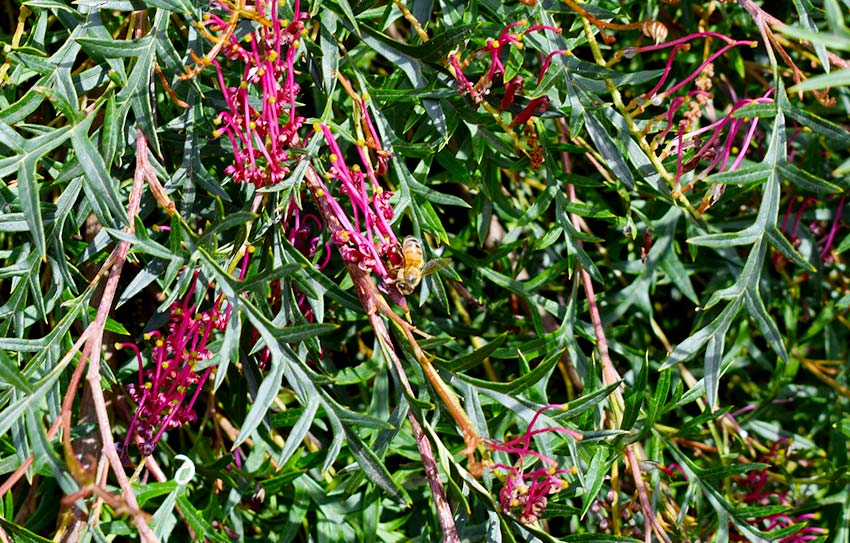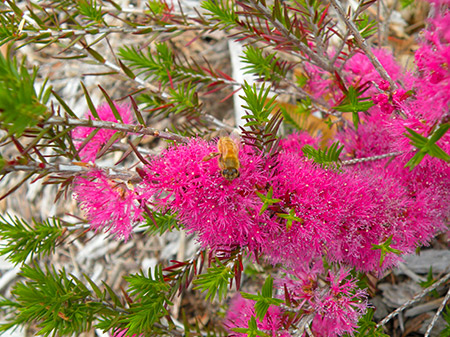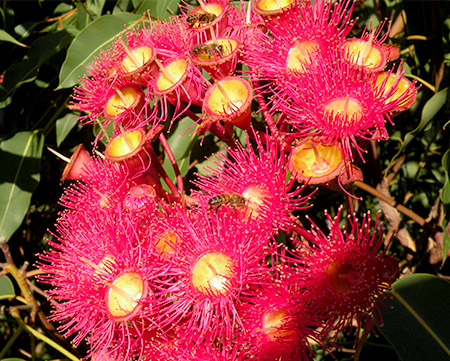As a beekeeper, it’s worth considering the types of plants you have in your backyard. A variety of plants which flower at different times of the year will help provide bees with enough pollen to thrive.
Bees have a strong relationship with flowering plants. They rely upon them for nectar and pollen which they use for food. Without a variety of flowering plants, bees would not survive.

The male part of a flower, or anther, produces pollen which is used by bees as their protein source. It is used in the making of bee bread which is fed to the developing larvae (or babies). The pollen is noticeable as the yellow or orange substance on the bees legs, having been accumulated as the bee moves about the flower.
Nectar is a sweet, sugary solution that provides the bees their energy source. The nectar is produced in glands called nectaries and is usually in the deepest part of the flower. As the bee moves about the flower, some of the pollen it has collected will be brushed onto the stigma, or female part, thus pollinating the flower.
When observing my own foraging bees, I’ve noticed they will visit many flowers on the one plant during the one foraging trip before they return to the hive. This makes sure plants of the one species will be successfully pollinated, ensuring their survival.
Plants That Attract Bees
As a beekeeper it’s a sensible idea to ensure the area around your hives is filled with flowering plants that will provide good supplies of the pollen and nectar bees need. Like all living creatures, bees need an array of different flowering plants so their diet is varied and provides all the necessary nourishment. There are some considerations you need to think about before choosing what to plant. Before discussing these, have a look around your garden and take note of the plants you already have. Ask yourself these questions:
- Do they flower? If so, what time/s of year?
- How long do they flower for?
- Are the flowers frequented by European bees or other pollinators?
This assessment of your garden will help you determine what plants you need to add in order for your bees to have year-round access to nourishing flora. Of course, bees aren’t going to just visit your garden. They can fly several kilometers in search of a worthy food source. But it certainly helps if they do not have to expend a lot of energy in search of food.
When Does The Plant Flower And For How Long?
Before choosing plants for your bee-friendly garden you need to find out what time of year the plants actually flower – and for how long. Perhaps the plant will flower more than once in the year or it will have a long flowering season. Either of these traits mean the plant is worth considering for your garden.

Many plants just flower in the Spring, but they provide an abundance of nectar and pollen at that time. This is beneficial to the bees because it is the time of year when the hive is expanding in numbers and more food is needed to feed the developing brood.
Once you find some suitable plants limit yourself to a few to start with. Ensure the plants flower at different times of the year. Buy three to four plants of the same sort and group them together because the bees will access all the flowers from the same type of plants during one trip.
I’d suggest not buying too many in the beginning because you need to find out how well the plants will grow in your area and in your soil. It’s important to have plants that flower in late Summer and Autumn too because the colony needs to build up stores of food to see it through the Winter.
It’s worth talking with an experienced beekeeper in your area to find out what plants they have growing in their garden that attract bees. From walking around your neighborhood at different times you will soon see what plants are most visited by bees.
Also go to a plant nursery and tell the nurseryman what you are looking for. Describe your garden’s characteristics of light, shade and soil type so that you can make an informed plant choice.
Flower Color
Bees have complicated compound eyes, thousands of tiny lenses that are united by the bee’s brain to make one picture. A group of plants of the same ‘bee-friendly’ color that are flowering together will stand out more to a bee than one single specimen.
Bees are strongly drawn to the colors blue, purple, violet, white and yellow. Bees can detect ultra violet light, something we as humans cannot do. Many of the features of a flower that are attractive to bees are not seen by us. You can ensure bees are attracted to your garden by having groups of plants of different heights and sizes grouped together. Place them in sunny locations in your garden as bees prefer to visit plants that are exposed to the sun for lengths of time.

Native Plants or Exotic
My own garden is made up of mostly native and indigenous plants and this was a decision we made when designing the garden. This was before I retired and decided to take up beekeeping.
European honey bees have become well adapted to the native flora of Australia, in particular Eucalyptus trees which produce copious amounts of nectar when in flower. We live adjacent to a state park which has many eucalyptus trees.
If you have a preference for plants that are indigenous or native to your area, I’d suggest you visit native plant nurseries and consult with the nursery staff to find out which plants would be preferred by bees and other pollinators. As well as this, members of your local beekeeping club may advise you as to which plants are favored by bees.
Our garden, although mostly native, also has four vegetable plots and a herb garden. Often we allow some of our vegetables to flower in order to collect seed, and these plants are favored by the bees also. Many of the non-native plants are contained in pots and are scattered throughout the garden together in sunny locations.

The Use Of Sprays In Your Garden
A word of warning here. If you use commercial sprays or powders to control unwanted insects or weed species in your garden you must consider the effects they will have on the bees and on other beneficial insects before you use them. The sprays can be taken back to the hive via the pollen or nectar collected and can severely compromise the health of the colony.
Remember also there are most likely other bee colonies in your area that will be impacted by what you do. Insecticides and powders don’t discriminate between the pests and the beneficial insects.
There may be another non-toxic alternatives for your garden. Natural alternatives can be sourced via the Internet, books or magazines.
Conclusion
It doesn’t matter what size your garden is – you can always incorporate more bee-friendly plants. You may not want to change your existing garden too much, but you can always find an area to add to or renovate with flowering plants that are suitable for your bees and other visiting pollinators.
